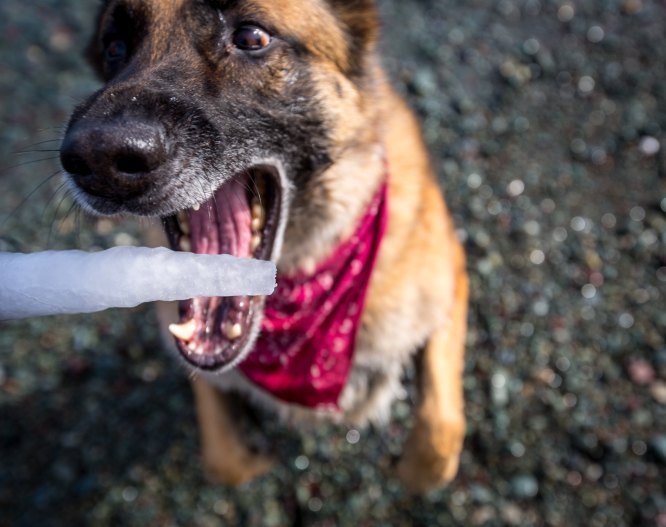“This post contains affiliate links, and I will be compensated if you make a purchase after clicking on my links.”

Dear Steve,
I have a German Shepard cross Kelpie who I rescued when she was 8 months old, she is now 5 yrs. I have two problems with her, the first is she is over protective around the home and when we’re at the dog beach she will often run and jump up to people as she runs past them. This is very intimidating as she’s a big dog. She tends to stalk them first then when I call her she runs up to them. The second problem which only happened recently is she killed our two hens, unfortunately my husband locked her in their pen unintentionally. I’m unsure how to deal with her, will she now kill other animals?”
Regards,
Carol
Hi Carol,
This is an interesting question, with an important takeaway for all dog owners. In my opinion, proper management is a concept that is often overlooked or improperly utilized.
The two types of management we will discuss are: short-term and long-term. A proper training plan should incorporate a short-term management component and depending on the complexity, a long-term component.
Short-term management refers to the management techniques/tools used while we go through the training process. A long-term management protocol is what we do after the training plan is complete. The goal of any management plan is to set the dog, humans, and other animals up for success. We do this by helping to prevent an incident of aggression, noncompliance, unnecessary/excessive fear, etc.
What are several examples of management tools and techniques?
Tools include: A crate, leash/long line, muzzle, placing the dog in another room, limiting freedom, etc.
Here are just a few possible examples of how these tools could be used in both a short-term and long-term management plan.
Crate:
Short-term: Aids in the housebreaking process, but may no longer be necessary once the puppy is housebroken.
Long-term: A dog with separation anxiety may always need a crate when left home alone (in order to keep the dog safe and feeling more comfortable).
Leash/Long Line:
Short-term: Allowing your puppy to drag a short leash in the home (only when supervised) helps mitigate biting/mouthing and enables you to clearly teach the concepts of “Off” & “Leave It”.
Long-term: A dog who is not fully off-leash obedience trained should remain on leash when in an unfenced outdoor area.
Muzzle:
Short-term: When properly used by a professional, a muzzle can be great for helping train an aggressive dog.
Long-term: Certain dogs may always need to wear a muzzle when visiting the Veterinarian for a medical exam.
Placing dog in a separate room:
Short-term: Place a dog who is reactive toward the vacuum cleaner in another room until they learn to remain in a “Down-Stay” while you vacuum.
Long-term: You can put a dog with aggressive tendencies in a separate room when the cable repairman arrives – as the risk is not worth the reward of him meeting the dog.
Limiting Freedom:
Short-term: A new puppy or recently adopted dog should not have access to every room of the home. Gradual exposure is best.
Long-term: Certain dogs should never go to the dog park, as other activities and socialization options would be better.
Whenever I discuss the concept of management, I get one of two responses: either owners never knew they could utilize these tools/techniques, so they find it a relief that they can OR they think it is punishment to implement a protocol like this.
I want to debunk the false idea that proper management is punishment, as it simply is NOT. As I stated earlier, management is meant to keep the dog, humans and other animals safe, while providing the best quality of life possible. We must remember that freedom is not entitled, it is earned. Once the dog is improved and reliable through the use of proper training, we can then provide more freedom.
We use both short-term and long-term management every day in our human lives and think nothing of it. Children always use training wheels (short-term management technique) when learning to ride a bike, and they are removed when the time is right. What is one of the first things we do when we get in the car? We put our seat belt on (long-term management technique).
I believe we are doing our pets a disservice by not doing the same in their life. I am even going to go as far as to say we would have significantly fewer dogs in our U.S. shelter system if more owners used proper management techniques.
Now let me directly answer Carol’s question…
Obviously you cannot have your dog “stalking” and jumping on people. The first thing I would do is simply not allow her off-leash in a public setting until she is reliably off-leash obedience trained. I would keep her on a leash/long line that I am in possession of. This is short-term management to help prevent her from being able to jump on people. I would also teach her a rock solid recall command (“Come”), that way you can call her back before she even starts to “stalk” or run toward a person.
In regards to your husband unintentionally locking her in a pen with the two hens… Obviously it is very sad both hens were killed, but not an unexpected outcome. I don’t think it is an atypical reaction for a predatory animal to kill a wild prey animal when contained together in close confinement. With that said, I have no way of knowing what her future actions will be towards hens or other animals. I would have her on a leash/long line and supervise her interactions with other animals in the near future. Once she continually proves to make safe and appropriate choices, you should have her re-evaluated by a local professional in order to determine if more freedom can be given.
The important takeaway I want to leave you with is this: Proper short-term and/or long-term management protocols are widely underutilized. When combined with a sound training program, they can result in a happier and less stressful life for both dog and owner.
Steve Reid is a Certified Dog Trainer and owner of S.R. Dog Training in Westchester, NY. For more information about S. R. Dog Training and to sign-up for his newsletter, visit www.srdogtraining.com. Please also become a fan of Steve on Facebook at www.Facebook.com/SRDogTraining.
Do you have a tough training question of your own? Ask the trainer by clicking here.



















Katelynn Cain
Apr 6, 2017 at 7:16 pm
I have a female German short-hair named Recoil. She is three years old, she is the youngest of the three we have. Recoil listens to me very well, she knows what "no" means, I can leave her in my front yard and she won't leave. But she is too protective. She won't let our other dogs in my room or get close to me when I am sitting on the couch. When I take her on walks she will let some people walk passed us just fine. Others she will bark and try to run up to them, She doesn't get along with any other dogs, she will not let any dog get close to me and if they keep getting closer to us she will try and start a fight, when I see a loose dog I have to pick her up and hold on to her as tight as I can and try to calm her down. She has never hurt any one but I'm not going to risk it. How do I fix this?
Lori
Nov 7, 2016 at 1:03 pm
I have 2 female Pitbulls both of them are fixed. I rescued one she was around 7 months old. the second one my ex left with me as he didn’t want her we got her when she was 8 weeks old, now that she is almost a year old she has became protective of me when the other one comes around and aggressive, they got into a bad dog fight and I had to break them up. I don’t want to get rid of her but I don’t know what to do I keep them separated while I’m at work but I let them interact when I’m home, but I still feel uneasy is there anything I can do to help the situation